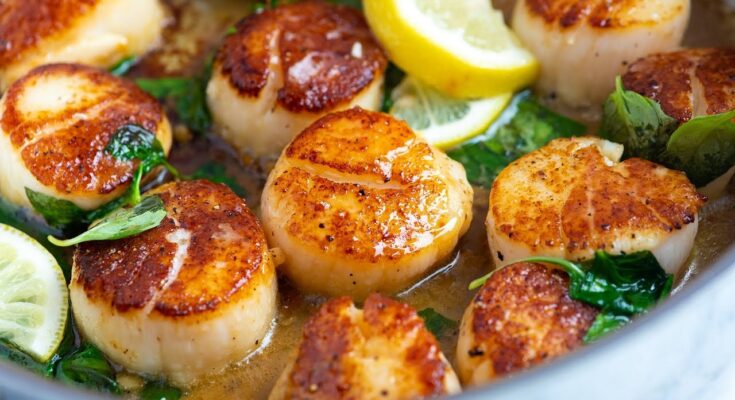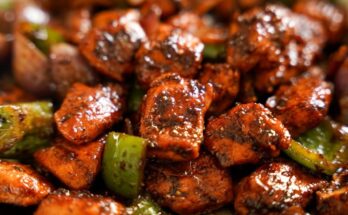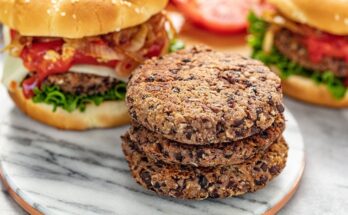Bay Scallops Recipe: Who doesn’t love a quick, delicious seafood meal that looks gourmet but takes less than 30 minutes from start to finish? That’s exactly what this bay scallops recipe delivers. With their sweet, delicate flavor and fast cook time, bay scallops are perfect for weeknight dinners, romantic evenings, or special gatherings. Whether you’re a home cook or just looking to try something new, this guide will walk you through everything—from picking the best scallops to serving them with style. Let’s dive in and bring the taste of the sea right to your plate!
What Are Bay Scallops?
Bay scallops are small, tender shellfish harvested from shallow bays and estuaries, especially along the East Coast of the U.S. They’re known for their sweet, mild flavor and soft texture, making them a favorite in both home kitchens and fine dining restaurants. Unlike sea scallops (which are much larger), bay scallops cook quickly and are perfect for dishes where you want that “melt-in-your-mouth” experience.
They typically range in size from 70 to 100 scallops per pound, which means you’ll need a handful for each serving. The best part? They’re incredibly versatile—you can sauté, grill, bake, or toss them into pasta.
Their natural sweetness pairs beautifully with garlic, lemon, butter, herbs, or even a spicy chili sauce. Once you’ve cooked them once, you’ll wonder why they weren’t already in your weekly meal rotation.
Why Choose Bay Scallops Over Sea Scallops?
Let’s get this straight: both types of scallops are delicious, but bay scallops have a few unique advantages:
- Quick Cooking Time: Bay scallops can cook in just 2–3 minutes. That’s perfect for busy nights.
- Sweeter Flavor: Their small size packs a lot of sweet, briny taste that many people prefer over sea scallops.
- Budget-Friendly: They’re generally more affordable than sea scallops, especially when bought frozen.
- Versatile for Smaller Dishes: Ideal for light pasta, risotto, or even as a topping on a salad.
Sea scallops are great for searing and more meaty textures, but bay scallops win when you want delicate flavor with a fast prep time. They’re the underdogs of the seafood world—totally underrated but unforgettable once tried.
Health Benefits of Bay Scallops
Bay scallops aren’t just tasty—they’re healthy too! Here’s what you get in each serving:
- High-Quality Protein: Great for muscle repair and satiety.
- Low in Calories: Perfect if you’re watching your waistline.
- Rich in Omega-3 Fatty Acids: Helps reduce inflammation and supports heart health.
- Packed with Vitamins & Minerals: Including B12, magnesium, and zinc.
- Low Mercury Levels: Compared to many other seafood options, scallops are a safer choice for regular consumption.
Plus, they’re naturally gluten-free and keto-friendly. Clean eating? Bay scallops are right on your plate.
Ingredients You’ll Need
Let’s keep it simple and flavorful. Below is a classic recipe list to bring out the best in bay scallops:
Main Ingredients
- 1 lb fresh or frozen bay scallops, thawed if frozen
- 2 tablespoons olive oil
- 2 tablespoons unsalted butter
- 3 cloves garlic, minced
- Juice of 1 lemon
- Salt and black pepper, to taste
- 2 tablespoons fresh parsley, chopped (optional)
- Pinch of red pepper flakes (optional, for heat)
Fresh vs Frozen Scallops
- Fresh: Always the best if you can find them. Look for a clean ocean smell and a firm texture.
- Frozen: Still a great option. Just be sure to thaw them in the fridge overnight and pat them dry before cooking. Avoid those soaked in sodium tripolyphosphate (STPP)—they don’t sear well.
Optional Add-Ons for More Flavor
- White wine (for deglazing)
- Grated Parmesan (for pasta dishes)
- Cream or butter sauce base
- Capers or shallots for a gourmet twist
Gather everything before you start. Scallops cook fast—there’s no time to chop garlic once they hit the pan!
Kitchen Tools You’ll Need
Here’s a quick list of what you’ll want on hand:
- Cast iron skillet or heavy-bottomed non-stick pan
- Paper towels (for drying scallops)
- Tongs or a slotted spoon
- Mixing bowl (for marinating, if desired)
- Garlic press or knife
- Lemon squeezer
- Plate with paper towel (for resting)
Having your tools ready means no scrambling once the scallops start sizzling!
Preparation Tips Before You Start Cooking
This is where most people mess up—scallops are sensitive and need a little love before they hit the heat.
- Dry Thoroughly: Pat them dry with paper towels. Wet scallops won’t brown; they’ll steam.
- Remove the Muscle: Some scallops have a tough side muscle attached. It’s small and easy to pull off.
- Room Temp Matters: Let them sit at room temperature for 10–15 minutes before cooking to ensure even searing.
- Don’t Overcrowd: If cooking a full pound, cook in batches to avoid lowering the pan temperature.
Treat this like prepping for a steak. The details make all the difference.
Step-by-Step Guide to Cook Perfect Bay Scallops
Let’s walk through the full process so you never overcook (or under-season) your scallops again.
Step 1: Rinse and Dry the Scallops
Rinse gently under cold water. Pat dry with multiple layers of paper towel until they’re moisture-free. The drier they are, the better the sear.
Step 2: Marinate (Optional but Worth It)
Toss scallops with a bit of olive oil, minced garlic, and lemon juice. Let them marinate for 5–10 minutes for deeper flavor. Don’t overdo it—too long and they’ll lose firmness.
Step 3: Heat the Pan (Don’t Skip This)
Place your skillet over medium-high heat. Add olive oil and wait until it’s shimmering. The pan must be hot before scallops go in.
Step 4: Sear the Scallops – Golden Perfection
Add scallops in a single layer. No touching. Leave them undisturbed for 1.5–2 minutes until the underside is golden. Flip and cook another 1–1.5 minutes. Don’t move them around. Let the crust form.
Step 5: Add Butter and Garlic for Extra Flavor
Lower heat slightly, add butter and remaining garlic. Tilt the pan and spoon the melted garlic butter over the scallops for a minute.
Step 6: Deglaze the Pan (Optional Sauce Creation)
Add a splash of white wine or lemon juice. Let it bubble for 30 seconds and drizzle it over the scallops for a simple, bright sauce.
Step 7: Serve and Garnish
Remove from heat, plate immediately. Sprinkle with fresh parsley, a crack of black pepper, and an extra lemon squeeze if you like.
That’s it! Restaurant-quality scallops right from your kitchen.
What to Serve with Bay Scallops
Alright, so your scallops are sizzling hot and perfectly golden. Now what? The magic isn’t just in the scallops—it’s in what you serve them with. Pairing bay scallops with the right sides can turn a simple dish into a full-blown gourmet experience. Let’s break it down:
Best Side Dishes
- Garlic Butter Pasta: Toss some linguine or angel hair in garlic butter with a pinch of chili flakes. Top with scallops and a squeeze of lemon—pure heaven.
- Lemon Herb Rice: A bright, zesty rice dish balances the richness of the scallops.
- Creamy Risotto: This is a classic combo. Go for a parmesan or lemon risotto and let the scallops shine.
- Grilled Asparagus or Broccolini: Their crunch and char complement the soft texture of scallops.
- Roasted Potatoes: Crispy on the outside, fluffy inside—scallops love a starchy side.
- Simple Green Salad: Toss with arugula, citrus segments, and a light vinaigrette to keep things fresh.
Wine Pairings That Work
Pairing scallops with wine? Yes, please. Here’s what works best:
- Chardonnay: Its buttery, oaky notes match the richness of seared scallops.
- Sauvignon Blanc: Crisp and citrusy—great if you’re using lemon or herbs in your recipe.
- Pinot Grigio: Light, refreshing, and easy to drink with a seafood-forward meal.
Remember, you’re aiming for balance. Keep it simple and let the scallops be the star of the show.
Bay Scallops Recipe Variations
Once you’ve nailed the basic recipe, you’ll want to experiment. Good news: bay scallops are versatile and ready to adapt to your creativity.
Bay Scallops Pasta
This is a crowd favorite. Cook your scallops as per the basic method, then toss them into a pasta dish with:
- Olive oil or light cream sauce
- Spinach, sun-dried tomatoes, or cherry tomatoes
- Fresh basil or parsley
- Parmesan cheese
Pro tip: Reserve a little pasta water to help emulsify your sauce. It makes all the difference.
Bay Scallops Tacos
Yes, you can taco-fy scallops. Here’s how:
- Lightly season scallops with chili powder and cumin
- Sear as usual
- Add to corn tortillas with slaw, avocado, and spicy mayo
- Squeeze of lime and you’ve got a coastal street food twist
Bay Scallops in Lemon Butter Sauce
Perfect for date night. After searing the scallops, add:
- 2 tablespoons butter
- Juice of one lemon
- A splash of white wine
- Garlic and parsley
Simmer until slightly thickened, then spoon the sauce over the scallops. Serve with rice or crusty bread. Easy elegance.
Common Mistakes to Avoid
Cooking scallops is quick, but there are a few pitfalls that can ruin the dish. Let’s avoid those.
- Not Drying Scallops Properly: Moist scallops = no sear = sad scallops.
- Overcrowding the Pan: They’ll steam instead of sear. Use a big skillet or cook in batches.
- Overcooking: This is the number one mistake. Scallops only need about 2–3 minutes total. Overcooked scallops turn rubbery real fast.
- Using Cold Scallops Straight from the Fridge: Let them come to room temperature to cook evenly.
- Too Much Lemon or Acid Too Early: It can “cook” the scallops like ceviche and ruin the texture.
Think of scallops like the filet mignon of the sea—they deserve attention and timing.
Tips to Store and Reheat Leftovers
While scallops are best fresh, you can still enjoy them later if you follow these tips:
Storing
- Refrigerate: Place leftovers in an airtight container. Eat within 2 days.
- Do Not Freeze Cooked Scallops: The texture gets rubbery when reheated.
Reheating
- Stovetop: Warm them gently in a pan over low heat with a bit of butter or sauce to keep them moist.
- Microwave (Not Ideal): Use 50% power for 20–30 seconds max. Too long and you’re eating rubber.
You won’t get that fresh sear again, but a careful reheat can still give you decent flavor.
Are Bay Scallops Kid-Friendly?
Absolutely. Their small size, sweet flavor, and soft texture make them ideal for kids. They’re not “fishy,” and when cooked right, they almost melt in your mouth. Serve with:
- Buttered noodles
- Rice and peas
- Mini taco shells
For picky eaters, skip the garlic and go with just butter and a pinch of salt. You’ll be surprised how quickly the plate disappears.
Bonus: They’re packed with protein and omega-3s—perfect for growing bodies.
How to Scale the Recipe for a Crowd
Cooking for a party or a family dinner? Here’s how to scale up without losing flavor or quality:
- Plan for 1/3 to 1/2 pound of scallops per person
- Cook in batches to avoid overcrowding your pan
- Keep cooked scallops warm in a low oven (200°F) while you finish the rest
- Double or triple the sauce if you’re serving pasta or rice
It’s easy to multiply the ingredients—just be patient with cooking. The key to crowd-pleasing scallops is cooking in small, hot batches for consistent results.
FAQs about Bay Scallops Recipe
1. Can I use frozen bay scallops for this recipe?
Yes, just make sure to thaw them completely in the fridge and pat them dry before cooking. Frozen scallops can release extra water, so drying is key to a good sear.
2. What’s the difference between wet and dry scallops?
Dry scallops haven’t been treated with preservatives or chemicals, so they sear better and taste sweeter. Wet scallops are often treated with STPP and may taste soapy or rubbery. Always choose dry scallops if possible.
3. How long should I cook bay scallops?
2–3 minutes total. About 1.5 minutes per side on medium-high heat. They should be opaque and slightly springy to the touch when done.
4. Can I grill bay scallops?
Yes, but it’s tricky due to their small size. Use a grill basket or skewers, and cook for just 1–2 minutes per side on high heat.
5. What herbs go well with bay scallops?
Parsley, thyme, tarragon, chives, and basil all work beautifully. Keep it fresh and light to complement their natural sweetness.
Final Thoughts
Bay scallops are the ultimate mix of elegance and ease. Whether you’re trying to impress guests or just spice up your weekly dinner routine, this recipe delivers every time. They cook in minutes, require minimal ingredients, and can be dressed up or down depending on the occasion. Once you get the hang of them, you’ll find yourself reaching for scallops again and again. Just remember: dry them well, don’t overcook, and always finish with a little love (aka butter, lemon, or herbs). Now go make something delicious!



